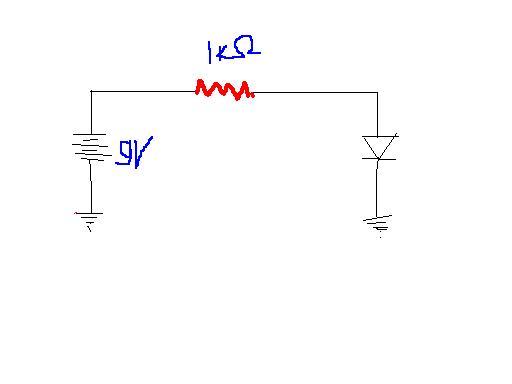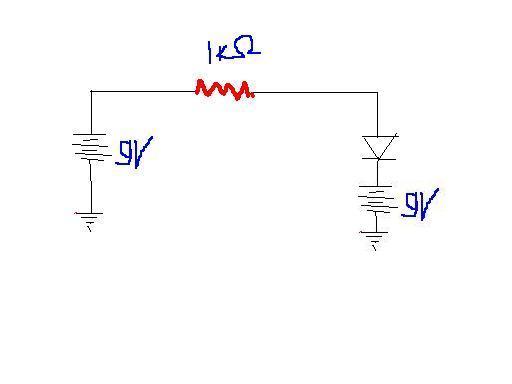k so itz same ike simple circuits i felt sumthing else
thanks everyone
 calculate d current thru d diode ....
calculate d current thru d diode ....
source voltage is 9V and source resitance is 1kohms

if its lik dis there arises a doubt whether current flows thro diode or not,, it gets even more complex if both vary in potential............say fr eg .9v , 6v....
but in dis case without a single doubt we can answer,.....
k so itz same ike simple circuits i felt sumthing else
thanks everyone
dats wat i said ....... i didn say dat he s wron........... i said those things not needed for dis one........
no bhaiya was not telling anything diff...
this one is a simple circuit... so u cud say so easily...
but commonly,,, in a loop, apply loop law n find the current ...
then, in find current through diodes acoording to connection
(forward or reverse... dat way..)
byah...there arises a doubt whether frwd biased or reverse biased only wen another potential is applieed in opp direc...
thx a lot yaar......... but byah was thinkin in diff way...
well ram an ideal diode
1. has 0 R in forward biasing
2. has ∞ R in reverse biasing
clearly in the fig p end is at high potential ie 9V
so diode is forward biased & its R=0
hence i=V/R=9/103=9*10-3
BYAH.. I DON THINK KVL S LAW IS NEEDED HERE...............
here d diodes r forward biased.....
so it ll conduct......
most probably d current thro d diode must be 9*10-3A
TYPE OF DIODE SHLD BE MENTIONED....................
Apply KVL's law..
and then see if the diode is forward or backward biased
Then if forward (current will not change!)
If backward current=0!!
Hmm.. sorry to confuse u..
Just thought that u were asking something complex:
I found a good set of definition and explanation fo diodes... somewhere on the net
Diodes allow electricity to flow in only one direction. The arrow of the circuit symbol shows the direction in which the current can flow.
Forward Voltage Drop
Electricity uses up a little energy pushing its way through the diode, rather like a person pushing through a door with a spring. This means that there is a small voltage across a conducting diode, it is called the forward voltage drop and is about 0.7V for all normal diodes which are made from silicon. The forward voltage drop of a diode is almost constant whatever the current passing through the diode so they have a very steep characteristic (current-voltage graph).
Reverse Voltage
When a reverse voltage is applied a perfect diode does not conduct, but all real diodes leak a very tiny current of a few µA or less. This can be ignored in most circuits because it will be very much smaller than the current flowing in the forward direction. However, all diodes have a maximum reverse voltage (usually 50V or more) and if this is exceeded the diode will fail and pass a large current in the reverse direction, this is called breakdown.
Src: http://www.kpsec.freeuk.com/components/diode.htm
ni diya......bt can u tell me hw 2 solve ssuch sums ....really i dnt noe d concept of diodes :(